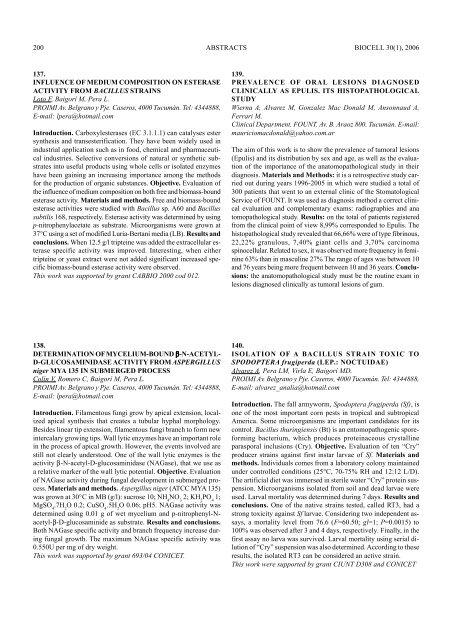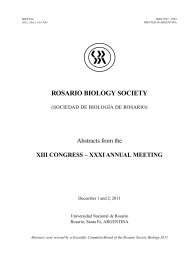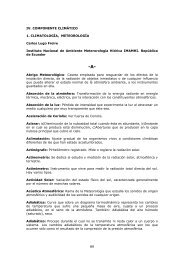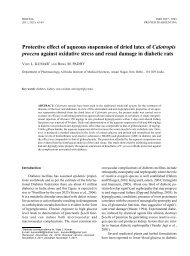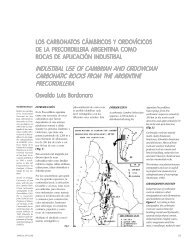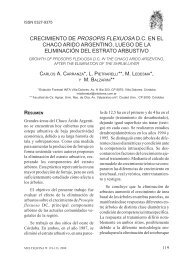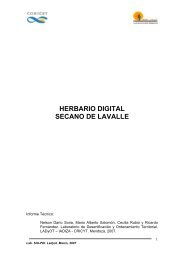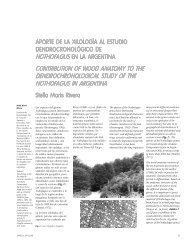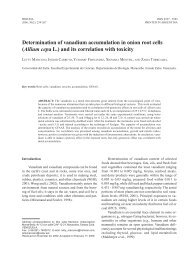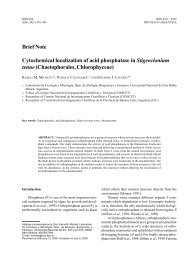XXII Annual Scientific Meeting, Tucuman Biology Society ...
XXII Annual Scientific Meeting, Tucuman Biology Society ...
XXII Annual Scientific Meeting, Tucuman Biology Society ...
Create successful ePaper yourself
Turn your PDF publications into a flip-book with our unique Google optimized e-Paper software.
200 ABSTRACTS<br />
137.<br />
INFLUENCE OF MEDIUM COMPOSITION ON ESTERASE<br />
ACTIVITY FROM BACILLUS STRAINS<br />
Loto F, Baigorí M, Pera L.<br />
PROIMI Av. Belgrano y Pje. Caseros, 4000 Tucumán. Tel: 4344888,<br />
E-mail: lpera@hotmail.com<br />
Introduction. Carboxylesterases (EC 3.1.1.1) can catalyses ester<br />
synthesis and transesterification. They have been widely used in<br />
industrial application such as in food, chemical and pharmaceutical<br />
industries. Selective conversions of natural or synthetic substrates<br />
into useful products using whole cells or isolated enzymes<br />
have been gaining an increasing importance among the methods<br />
for the production of organic substances. Objective. Evaluation of<br />
the influence of medium composition on both free and biomass-bound<br />
esterase activity. Materials and methods. Free and biomass-bound<br />
esterase activities were studied with Bacillus sp. A60 and Bacillus<br />
subtilis 168, respectively. Esterase activity was determined by using<br />
p-nitrophenylacetate as substrate. Microorganisms were grown at<br />
37°C using a set of modified Luria-Bertani media (LB). Results and<br />
conclusions. When 12.5 g/l tripteine was added the extracellular esterase<br />
specific activity was improved. Interesting, when either<br />
tripteine or yeast extract were not added significant increased specific<br />
biomass-bound esterase activity were observed.<br />
This work was supported by grant CABBIO 2000 cod 012.<br />
138.<br />
DETERMINATION OF MYCELIUM-BOUND β-N-ACETYL-<br />
D-GLUCOSAMINIDASE ACTIVITY FROM ASPERGILLUS<br />
niger MYA 135 IN SUBMERGED PROCESS<br />
Colín V, Romero C, Baigorí M, Pera L.<br />
PROIMI Av. Belgrano y Pje. Caseros, 4000 Tucumán. Tel: 4344888,<br />
E-mail: lpera@hotmail.com<br />
Introduction. Filamentous fungi grow by apical extension, localized<br />
apical synthesis that creates a tubular hyphal morphology.<br />
Besides linear tip extension, filamentous fungi branch to form new<br />
intercalary growing tips. Wall lytic enzymes have an important role<br />
in the process of apical growth. However, the events involved are<br />
still not clearly understood. One of the wall lytic enzymes is the<br />
activity β-N-acetyl-D-glucosaminidase (NAGase), that we use as<br />
a relative marker of the wall lytic potential. Objective. Evaluation<br />
of NAGase activity during fungal development in submerged process.<br />
Materials and methods. Aspergillus niger (ATCC MYA 135)<br />
was grown at 30°C in MB (g/l): sucrose 10; NH 4 NO 3 2; KH 2 PO 4 1;<br />
MgSO 4 .7H 2 O 0.2; CuSO 4 .5H 2 O 0.06; pH5. NAGase activity was<br />
determined using 0.01 g of wet mycelium and p-nitrophenyl-Nacetyl-β-D-glucosaminide<br />
as substrate. Results and conclusions.<br />
Both NAGase specific activity and branch frequency increase during<br />
fungal growth. The maximum NAGase specific activity was<br />
0.550U per mg of dry weight.<br />
This work was supported by grant 693/04 CONICET.<br />
BIOCELL 30(1), 2006<br />
139.<br />
PREVALENCE OF ORAL LESIONS DIAGNOSED<br />
CLINICALLY AS EPULIS. ITS HISTOPATHOLOGICAL<br />
STUDY<br />
Wierna A, Alvarez M, Gonzalez Mac Donald M, Ansonnaud A,<br />
Ferrari M.<br />
Clinical Department. FOUNT. Av. B. Araoz 800. Tucumán. E-mail:<br />
mauriciomacdonald@yahoo.com.ar<br />
The aim of this work is to show the prevalence of tumoral lesions<br />
(Epulis) and its distribution by sex and age, as well as the evaluation<br />
of the importance of the anatomopathological study in their<br />
diagnosis. Materials and Methods: it is a retrospective study carried<br />
out during years 1996-2005 in which were studied a total of<br />
300 patients that went to an external clinic of the Stomatological<br />
Service of FOUNT. It was used as diagnosis method a correct clinical<br />
evaluation and complementary exams: radiographies and ana<br />
tomopathological study. Results: on the total of patients registered<br />
from the clinical point of view 8,99% corresponded to Epulis. The<br />
histopathological study revealed that 66,66% were of type fibrinous,<br />
22,22% granulous, 7,40% giant cells and 3,70% carcinoma<br />
spinocellular. Related to sex, it was observed more frequency in feminine<br />
63% than in masculine 27% The range of ages was between 10<br />
and 76 years being more frequent between 10 and 36 years. Conclusions:<br />
the anatomopathological study must be the routine exam in<br />
lesions diagnosed clinically as tumoral lesions of gum.<br />
140.<br />
ISOLATION OF A BACILLUS STRAIN TOXIC TO<br />
SPODOPTERA frugiperda (LEP.: NOCTUIDAE)<br />
Alvarez A, Pera LM, Virla E, Baigorí MD.<br />
PROIMI Av. Belgrano y Pje. Caseros, 4000 Tucumán. Tel: 4344888,<br />
E-mail: alvarez_analia@hotmail.com<br />
Introduction. The fall armyworm, Spodoptera frugiperda (Sf), is<br />
one of the most important corn pests in tropical and subtropical<br />
America. Some microorganisms are important candidates for its<br />
control. Bacillus thuringiensis (Bt) is an entomopathogenic sporeforming<br />
bacterium, which produces proteinaceous crystalline<br />
parasporal inclusions (Cry). Objective. Evaluation of ten “Cry”<br />
producer strains against first instar larvae of Sf. Materials and<br />
methods. Individuals comes from a laboratory colony maintained<br />
under controlled conditions (25°C, 70-75% RH and 12:12 L/D).<br />
The artificial diet was immersed in sterile water “Cry” protein suspension.<br />
Microorganisms isolated from soil and dead larvae were<br />
used. Larval mortality was determined during 7 days. Results and<br />
conclusions. One of the native strains tested, called RT3, had a<br />
strong toxicity against Sf larvae. Considering two independent assays,<br />
a mortality level from 76.6 (F=60.50; gl=1; P=0.0015) to<br />
100% was observed after 3 and 4 days, respectively. Finally, in the<br />
first assay no larva was survived. Larval mortality using serial dilution<br />
of “Cry” suspension was also determined. According to these<br />
results, the isolated RT3 can be considered an active strain.<br />
This work were supported by grant CIUNT D308 and CONICET


